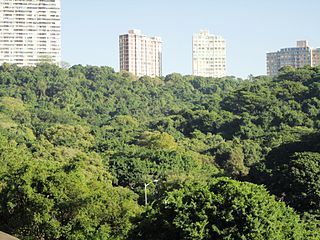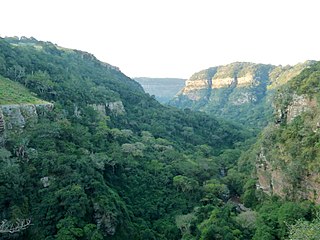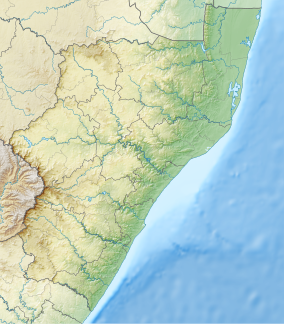
KwaZulu-Natal is a province of South Africa that was created in 1994 when the Zulu bantustan of KwaZulu and Natal Province were merged. It is located in the southeast of the country, enjoying a long shoreline beside the Indian Ocean and sharing borders with three other provinces, and the countries of Mozambique, Eswatini and Lesotho. Its capital is Pietermaritzburg, and its largest city is Durban. It is the second-most populous province in South Africa, with slightly fewer residents than Gauteng.

Durban, nicknamed Durbs, is the third most populous city in South Africa after Johannesburg and Cape Town and the largest city in the South African province of KwaZulu-Natal. Durban forms part of the eThekwini Metropolitan Municipality, which includes neighboring towns and has a population of about 3.44 million, making the combined municipality one of the largest cities on the Indian Ocean coast of the African continent. Durban was one of the host cities of the 2010 FIFA World Cup.
Ezemvelo KZN Wildlife is a governmental organisation responsible for maintaining wildlife conservation areas and biodiversity in KwaZulu-Natal Province, South Africa. Their headquarters is in Queen Elizabeth Park situated on the northern slopes of Pietermaritzburg, the KwaZulu-Natal provincial capital. Prior to 1994, it was known as the Natal Parks Board.

Mtunzini is a small coastal town that is situated almost exactly halfway along KwaZulu-Natal's coastline in South Africa approximately 140 km north of Durban. In 2011, the town's population was 2,199.

Amanzimtoti is a coastal town just south of Durban, KwaZulu-Natal, South Africa. The town is well known for its warm climate and numerous beaches, and is a popular tourist destination, particularly with surfers. The annual sardine run attracts many to the Toti beaches.

Westville is a town in KwaZulu-Natal, South Africa and is just west of Durban. It was a formerly independent town however it became part of the eThekwini Metropolitan Municipality in 2002. Westville is situated 10 km inland from the Durban CBD.

Durban North is an area to the north of Durban in the eThekwini Metropolitan Municipality, KwaZulu-Natal, South Africa. Durban North lies between the N2 freeway and the eastern seashore, with the Umgeni River forming its southern boundary. It has residential suburbs that are some of Durban's most affluent and is flanked by La Lucia in the north.

Umhlanga is an affluent residential, commercial and resort town north of Durban on the coast of KwaZulu-Natal, South Africa. It is part of the eThekwini Metropolitan Municipality, created in 2000, which includes the greater Durban area. The name means "place of reeds" in the Zulu language, and the correct pronunciation of "hl" in Umhlanga is similar to the Welsh "ll". It is bordered by Durban North to the south and Mt Edgecombe to the west.

Burman Bush is a nature reserve in Morningside, Durban, situated some 8 km north of the CBD. At about 50 hectares it constitutes a small circular enclave of coastal forest which forms part of the Durban Municipal Open Space System (D'MOSS). It is the northern remnant of a forest that once covered much of the Berea ridge. The reserve's elevation varies from 19 to 133 m a.s.l.

Pigeon Valley is a Natural Heritage Park and formally declared municipal nature reserve in Durban, South Africa. It is an unusual example of an urban reserve with very high levels of biodiversity. It was established to provide protection for the Natal elm and other forest giants of the coastal climax forest. Another rare tree that occurs here is Natal forest loquat, which is endemic to the Durban area and to oNgoye Forest. Pigeon Valley is about 11 ha in extent, and is situated on the Berea, overlooking Durban Bay. Its unusual north-south orientation may contribute to the biodiversity, with the south-facing slope covered in canopy forest, while the north-facing slope has thorny thickets. An adjoining reservoir, previously part of the reserve, provides a patch of coastal grassland.

Areas of forest which grow in KwaZulu-Natal, South Africa mostly on south facing slopes in higher rainfall areas, and along the humid coastal areas. Different types of forest can be identified by their species composition which depends mostly on the altitude, latitude and substrate in which they grow. South facing slopes are favourable for the development of forest as they are more shaded, and therefore cooler and retain more moisture than the northern slopes. The extra moisture on the south slopes is not only favoured by forest trees, but also helps to prevent or subdue wildfires. Fires can also be blocked by cliff faces and rocks or boulders on these slopes, and by streams or rivers at the base of the slopes. The coastal regions are conducive to forest formation, because of high rainfall and humidity which are favoured by forest trees and also help to prevent or subdue fires. The rivers of the coastal areas are also broader than further inland, which may often prevent fires from spreading long distances, and fires generally burn uphill and therefore more often away from areas at low altitude.

The Hawaan Forest is situated in Umhlanga, KwaZulu-Natal, South Africa. It is a large remnant of a climax dry coastal dune forest and the last of its kind. This forest grows on a dune that dates back 18,000 years. The Hawaan forest is currently under the guardianship of the Wildlife and Environment Society of Southern Africa (WESSA), but is owned by the Tongaat Hulett Group. The property was originally owned by the Campbell family who first settled there in 1859 and the Hawaan Forest has been protected since 1860. The Hawaan Forest Estate is known for being one of the most exclusive estates in the country.

Empisini Nature Reserve was established in 1973 and is situated in Umkomaas, KwaZulu-Natal, South Africa. The reserve is approximately 60 ha in extent and is owned by the borough of uMkhomanzi which has been incorporated into the eThekwini municipality. Empisini is managed jointly by eThekwini and the Umkomaas centre of the Wildlife and Environment Society of South Africa. Empisini takes its name from a perennial stream which flows through it, and means "Place of the Hyena" in isiZulu. The reserve consists of coastal forest, wetlands, grassy slopes and a dam. Infrastructure consists of hiking trails, demarcated picnic sites, overnight cabins, and a tree house.

The Krantzkloof Nature Reserve, managed by Ezemvelo KZN Wildlife, conserves 668 ha of the Molweni and Nkutu River gorges that incise the sandstone Kloof plateau in KwaZulu-Natal, South Africa. The reserve conserves coastal scarp forest, sourveld grassland, a cliff face biotope, and aquatic environments along its rivers. Scarp forest is a threatened forest type, protected by South Africa's forests act of 1998, while the grassland is classified as KwaZulu-Natal sandstone sourveld, the most threatened terrestrial habitat in the Durban metropole. The reserve was established in 1950 and was augmented by land donations as late as 1999.

Bluff Nature Reserve is a 45 hectare protected pan and forest in the suburb of The Bluff, Durban, South Africa. The park was proclaimed in 1974, making it Durban's oldest nature reserve, and is managed by Ezemvelo KZN Wildlife.

North Park Nature Reserve is a protected area along the banks of the Umhlatuzana River, near Queensburgh in KwaZulu-Natal, South Africa. The park was proclaimed in 1968 and is managed by Ezemvelo KZN Wildlife.

KwaZulu-Natal South Coast is a region on the southern coast of KwaZulu-Natal, South Africa. It stretches from Scottburgh in the north to Port Edward in the south and Harding in the west. The coast is governed by the Ugu District Municipality.

Silverglen Nature Reserve is a 460 hectare conservancy on the Umlaas River located aside the suburb of Silverglen, Chatsworth, KwaZulu-Natal in South Africa. The reserve is the largest piece of coastal grassland and bush clump mosaic in Greater Durban, and is home to the first medicinal plant nursery in Africa, established in 1986.

KwaZulu-Natal North Coast is a region on the northern coast of KwaZulu-Natal, South Africa. It stretches from Thukela Mouth in the north to Ballito in the south. The coast is governed by the iLembe District Municipality.














